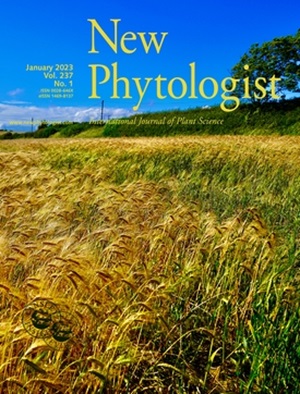The genetic architecture of floral trait divergence between hummingbird- and self-pollinated monkeyflower (Mimulus) species
IF 8.1
1区 生物学
Q1 PLANT SCIENCES
引用次数: 0
Abstract
- Pollination syndromes are a key component of flowering plant diversification, prompting questions about the architecture of single traits and genetic coordination among traits. Here, we investigate the genetics of extreme floral divergence between naturally hybridizing monkeyflowers, Mimulus parishii (self-pollinated) and M. cardinalis (hummingbird-pollinated).
- We mapped quantitative trait loci (QTLs) for 18 pigment, pollinator reward/handling, and dimensional traits in parallel sets of F2 hybrids plus recombinant inbred lines and generated nearly isogenic lines (NILs) for two dimensional traits, pistil length and corolla size.
- Our multi-population approach revealed a highly polygenic basis (n = 190 QTLs total) for pollination syndrome divergence, capturing minor QTLs even for pigment traits with leading major loci. There was significant QTL overlap within pigment and dimensional categories. Nectar volume QTLs clustered with those for floral dimensions, suggesting a partially shared module. The NILs refined two pistil length QTLs, only one of which has tightly correlated effects on other dimensional traits.
- An overall polygenic architecture of floral divergence is partially coordinated by genetic modules formed by linkage (pigments) and likely pleiotropy (dimensions plus nectar). This work illuminates pollinator syndrome diversification in a model radiation and generates a robust framework for molecular and ecological genomics.



蜂鸟和自花授粉猴头花(Mimulus)物种之间花性状差异的遗传结构
传粉综合征是开花植物多样化的一个关键组成部分,引发了关于单性状结构和性状间遗传协调的问题。在此,我们研究了自然杂交的猴花,Mimulus parishii(自花授粉)和M. cardinalis(蜂鸟授粉)之间的极端花分化的遗传学。在F2杂交组合和重组自交系的平行组合中,对18个色素、传粉者奖励/处理和维度性状的数量性状位点(qtl)进行了定位,获得了雌蕊长度和花冠大小等维度性状的近等基因系(NILs)。我们的多群体方法揭示了授粉综合征差异的高度多基因基础(n = 190个qtl),甚至在色素性状中也捕获了具有主要位点的次要qtl。在色素和尺寸类别中存在显著的QTL重叠。花蜜体积qtl与花尺寸qtl聚集在一起,表明二者部分共享。结果表明,两个雌蕊长度qtl中只有一个与其他维度性状密切相关。花分化的整体多基因结构部分由连锁(色素)和可能的多效性(尺寸加花蜜)形成的遗传模块协调。这项工作阐明了传粉者综合征多样化的模型辐射,并产生了一个强大的框架分子和生态基因组学。
本文章由计算机程序翻译,如有差异,请以英文原文为准。
求助全文
约1分钟内获得全文
求助全文
来源期刊

New Phytologist
生物-植物科学
自引率
5.30%
发文量
728
期刊介绍:
New Phytologist is an international electronic journal published 24 times a year. It is owned by the New Phytologist Foundation, a non-profit-making charitable organization dedicated to promoting plant science. The journal publishes excellent, novel, rigorous, and timely research and scholarship in plant science and its applications. The articles cover topics in five sections: Physiology & Development, Environment, Interaction, Evolution, and Transformative Plant Biotechnology. These sections encompass intracellular processes, global environmental change, and encourage cross-disciplinary approaches. The journal recognizes the use of techniques from molecular and cell biology, functional genomics, modeling, and system-based approaches in plant science. Abstracting and Indexing Information for New Phytologist includes Academic Search, AgBiotech News & Information, Agroforestry Abstracts, Biochemistry & Biophysics Citation Index, Botanical Pesticides, CAB Abstracts®, Environment Index, Global Health, and Plant Breeding Abstracts, and others.
 求助内容:
求助内容: 应助结果提醒方式:
应助结果提醒方式:


